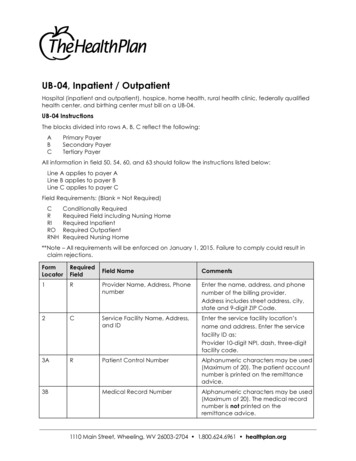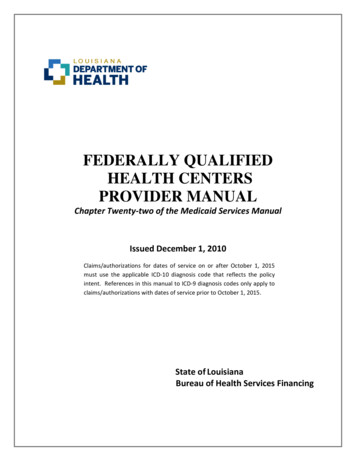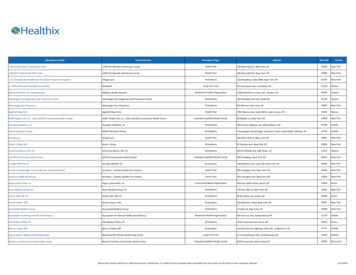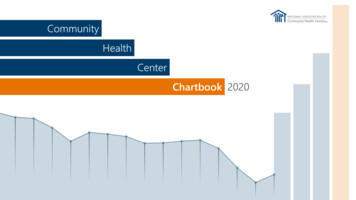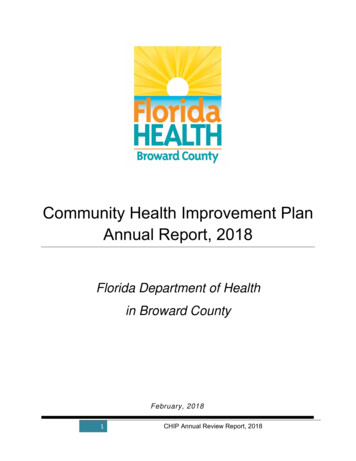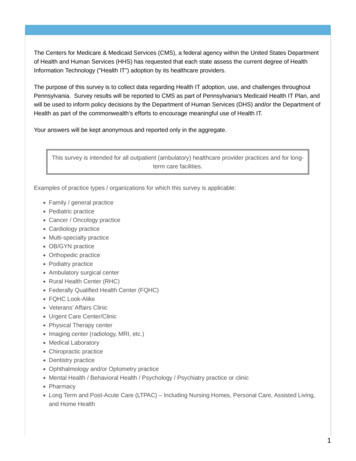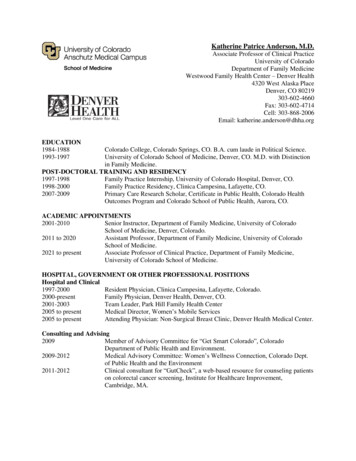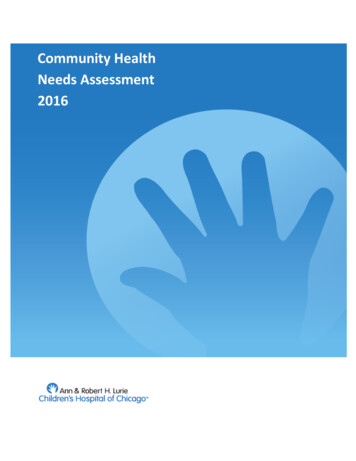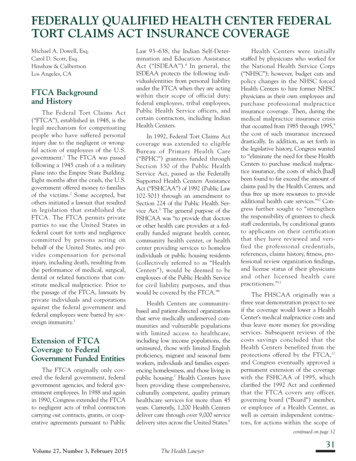
Transcription
FEDERALLY QUALIFIED HEALTH CENTER FEDERALTORT CLAIMS ACT INSURANCE COVERAGEMichael A. Dowell, Esq.Carol D. Scott, Esq.Hinshaw & CulbertsonLos Angeles, CAFTCA Backgroundand HistoryThe Federal Tort Claims Act(“FTCA”), established in 1948, is thelegal mechanism for compensatingpeople who have suffered personalinjury due to the negligent or wrongful action of employees of the U.S.government.1 The FTCA was passedfollowing a 1945 crash of a a militaryplane into the Empire State Building.Eight months after the crash, the U.S.government offered money to familiesof the victims.2 Some accepted, butothers initiated a lawsuit that resultedin legislation that established theFTCA. The FTCA permits privateparties to sue the United States infederal court for torts and negligencecommitted by persons acting onbehalf of the United States, and provides compensation for personalinjury, including death, resulting fromthe performance of medical, surgical,dental or related functions that constitute medical malpractice. Prior tothe passage of the FTCA, lawsuits byprivate individuals and corporationsagainst the federal government andfederal employees were barred by sovereign immunity.3Extension of FTCACoverage to FederalGovernment Funded EntitiesThe FTCA originally only covered the federal government, federalgovernment agencies, and federal government employees. In 1988 and againin 1990, Congress extended the FTCAto negligent acts of tribal contractorscarrying out contracts, grants, or cooperative agreements pursuant to PublicLaw 93–638, the Indian Self-Determination and Education AssistanceAct (“ISDEAA”). 4 In general, theISDEAA protects the following individuals/entities from personal liabilityunder the FTCA when they are actingwithin their scope of official duty:federal employees, tribal employees,Public Health Service officers, andcertain contractors, including IndianHealth Centers.In 1992, Federal Tort Claims Actcoverage was extended to eligibleBureau of Primary Health Care(“BPHC”) grantees funded throughSection 330 of the Public HealthService Act, passed as the FederallySupported Health Centers AssistanceAct (“FSHCAA”) of 1992 (Public Law102-501) through an amendment toSection 224 of the Public Health Service Act.5 The general purpose of theFSHCAA was “to provide that doctorsor other health care providers at a federally funded migrant health center,community health center, or healthcenter providing services to homelessindividuals or public housing residents(collectively referred to as “HealthCenters”), would be deemed to beemployees of the Public Health Servicefor civil liability purposes, and thuswould be covered by the FTCA.”6Health Centers are communitybased and patient-directed organizationsthat serve medically underserved communities and vulnerable populationswith limited access to healthcare,including low income populations, theuninsured, those with limited Englishproficiency, migrant and seasonal farmworkers, individuals and families experiencing homelessness, and those living inpublic housing.7 Health Centers havebeen providing these comprehensive,culturally competent, quality primaryhealthcare services for more than 45years. Currently, 1,200 Health Centersdeliver care through over 9,000 servicedelivery sites across the United States.8Health Centers were initiallystaffed by physicians who worked forthe National Health Service Corps(“NHSC”); however, budget cuts andpolicy changes in the NHSC forcedHealth Centers to hire former NHSCphysicians as their own employees andpurchase professional malpracticeinsurance coverage. Then, during themedical malpractice insurance crisisthat occurred from 1985 through 1995,9the cost of such insurance increaseddrastically. In addition, as set forth inthe legislative history, Congress wantedto “eliminate the need for these HealthCenters to purchase medical malpractice insurance, the costs of which [had]been found to far exceed the amount ofclaims paid by the Health Centers, andthus free up more resources to provideadditional health care services.”10 Congress further sought to “strengthenthe responsibility of grantees to checkstaff credentials, by conditional grantsto applicants on their certificationthat they have reviewed and verified the professional credentials,references, claims history, fitness, professional review organization findings,and license status of their physiciansand other licensed health carepractitioners.”11The FHSCAA originally was athree year demonstration project to seeif the coverage would lower a HealthCenter’s medical malpractice costs andthus leave more money for providingservices. Subsequent reviews of thecosts savings concluded that theHealth Centers benefited from theprotections offered by the FTCA,12and Congress eventually approved apermanent extension of the coveragewith the FSHCAA of 1995, whichclarified the 1992 Act and confirmedthat the FTCA covers any officer,governing board (“Board”) member,or employee of a Health Center, aswell as certain independent contractors, for actions within the scope ofcontinued on page 32Volume 27, Number 3, February 2015The Health Lawyer31
Federally Qualified Health Center Federal Tort Claims Act Insurance Coveragecontinued from page 31their employment or contract.13 TheFSHCAA also extended FTCA coverage to Veterans AdministrationMedical Centers and outpatient clinics, Military Hospitals, Indian HealthCenters, the NHSC, the PublicHealth Service, and Free Clinics.How FTCA Coverage forHealth Centers Differsfrom FTCA Coveragefor Government AgenciesFTCA Coverage for Health Centers is different from that provideddirectly to government agencies, andfrom insurance coverage provided bycommercial medical malpracticeinsurers. Health Centers must meetvery specific requirements in order tobe covered by the FTCA, and manycommon activities engaged in byHealth Centers and which might becovered by private malpractice insurance are not covered by the FTCA.Health Centers must meet rigid deeming requirements. Health Centers mustoperate within the parameters of theFTCA program rules to ensure thatthe Health Center does not jeopardizeits FTCA coverage and to ensure thatit does not exceed the limitations onthe scope of coverage for certain staffmembers or services provided to certain patients.The FTCA provides occurrencebased coverage for professionalmalpractice to a Health Center thatis “deemed” eligible by the HealthResources and Services Administration (“HRSA”) of the Department ofHealth and Human Services (“HHS”),but only for claims arising from acts oromissions by the Health Center, itsqualified individual providers and/orother eligible individuals (i.e., Boardmembers, officers, employees and certain individual contractors or theHealth Center) that (1) occur on orafter the effective date that HRSAdetermined the Health Center met32the requirements for FTCA coverage;(2) are within that Health Center’sapproved scope of project and occurduring the provision of services toHealth Center patients (or non-patientsin certain limited situations);14 and (3)are within the requirements of the jobdescription, contract for services, HealthCenter scope of employment, or dutiesas an officer or director of the HealthCenter.15After a claim is filed against aHealth Center, the Health Center musttake deliberate steps to access coverageunder the FTCA. Failure to performthe required steps may put the HealthCenter’s FTCA coverage at risk.Benefits of FTCA CoverageFree Medical MalpracticeInsurance CoverageFTCA coverage provides significant benefits, including a reduction orelimination of professional liabilityinsurance costs and unlimited coverage. There is no cost to participatingHealth Centers or their providers, andthere is no personal liability for covered individuals. In addition, HealthCenters are not limited to the traditional coverage limits of one milliondollars per incident and three milliondollars in the aggregate. Covered entities are not liable for any settlementsor judgments that are made, as the federal government assumes responsibilityfor related costs. The Health Centerand its officers, directors, employeesand certain contractors covered by theFTCA are considered to be federalemployees for the purpose of malpractice coverage under the FTCA, but arenot considered federal employees forany other reason. Currently 956Health Centers are deemed eligible byHRSA for FTCA medical malpracticecoverage.16discouraging litigation. For example,there is a federal two year statute oflimitations from the time a plaintiffdiscovered or should have discoveredthe injury (no competency or minorage tolling of statute of limitations),and the preliminary administrativereview process serves as another statute of limitations if a lawsuit is notfiled within six months after theclaim was denied or failed to settle. Inaddition, there is no common law discovery rule, no jury and no punitivedamages.Claims, Scrutiny Expectedto IncreaseOne of the central funding initiatives in the Patient Protection andAffordable Care Act is the expansionof Health Centers as a means ofimproving access to primary healthcare, and the number of HealthCenters is increasing rapidly. HealthCenters are likely to play a centralrole in the country’s health systemover the coming years, as HealthCenters currently provide care tomore than 22 million people, and anincreasingly number of consumerswill be obtaining healthcare servicesfrom Health Centers in the future.17As more Health Centers are established, the number of medicalmalpractice claims involving HealthCenters will also likely increase.Plaintiffs’ attorneys, their clients, andHealth Center attorneys and compliance officers must be aware of FTCArequirements.FTCA rules make it harder for aplaintiff to recover damages, therebyIn addition, the 2015 Work Plan ofHHS’ Office of Inspector General(“OIG”) indicates that the OIG will beauditing Health Center compliance,18and HRSA has recently begun toconduct random FTCA coverage compliance site visits of both Health Centerinitial applicants and deemed granteesto determine compliance with FTCAprogram requirements.19The Health LawyerVolume 27, Number 3, February 2015Reduced Liability Risks
The purpose of this article is toprovide guidance to plaintiffs’ counsel, Health Center legal counsel, andHealth Center compliance officers onhow to comply with the applicableFTCA requirements.The Federal Tort ClaimsAct Health Center PolicyManualThe Federal Tort Claims ActHealth Center Policy Manual (the“FTCA Manual”) is the primarysource for information on the FTCAprogram for Health Centers andrelated stakeholders.20 HRSA recentlyissued an updated FTCA Manualwhich modifies and supersedes theprior manual (Policy InformationNotice (“PIN”) 2011-01), and reflectsamendments to the FTCA HealthCenter regulations. 21 HRSA alsoissued a Program Assistance Letter(“PAL”) that highlights the updatesand modifications (“PAL 2014-09”).22The revised FTCA Manual isintended to be the principal HealthCenter Program resource on FTCAmatters; however if there are any conflicts between the Manual and theFTCA and regulations as interpretedby the courts, the FTCA, implementing regulations, and case law prevail.23New changes reflected in theFTCA Manual include the following:Individual EmergenciesThe updated FTCA Manualincludes an expansion of FTCA coverage for services rendered to non-HealthCenter patients in certain individualemergencies. To be covered by theFTCA when temporarily treating orassisting in treating a non-HealthCenter patient, the treatment musttake place in or near the Health Center provider’s location, the providermust be furnishing (or about to furnish) FTCA covered services withinthe Health Center’s scope of projectand must be asked, called upon orundertake to treat or assist in treatingthe non-Health Center patient. Inaddition to documentation of theoriginal services, the Health Centermust have documentation (such as anemployee manual, provider contract orHealth Center bylaws) that providesthat a practitioner is required as acondition of employment to provideindividual emergency treatment whenthe practitioner is already providing orundertaking to provide covered services.Participation in Health FairsThe updated FTCA Manual clarifies that Health Center staff thatconduct or participate in health fairsare covered by the FTCA.Immunization CampaignsThe updated FTCA Manual clarifies that Health Center staff thatconduct or participate in an event toimmunize individuals against infectiousillnesses are covered by the FTCA.Covered immunization campaignsnow include those provided to adults,in addition to those provided to children and adolescents.24The FTCA Manual is generallyupdated infrequently and limited tosignificant updates, as minor changesare usually communicated in PINs orPALs.The FTCA CoverageApplication and CoverageRenewal ProcessEach Health Center seeking FTCAcoverage (including both Health Centergrantees and sub-recipients) must submit an application in the form andmanner prescribed by HRSA. All applications, whether initial or renewalapplications, must be submittedthrough the FTCA deeming modulewithin the HRSA Electronic Handbook (“EHB”). The application mustdocument that the Health Center hassuccessfully implemented all programrequirements set forth in the FTCAand regulations and further describedin HRSA guidance entitled “Calendar Year 2015 Requirements forFederal Tort Claims Act (FTCA)Medical Malpractice Coverage forHealth Centers.”25 Program requirements include not only the submissionof written documentation of appropriate policies, procedures, andpractices, but also evidence of theirimplementation.26In view of the importance of theapplication process, it is essential thatall applicants for coverage or annualrenewal: Submit FTCA application materials in a timely manner (includingresponding within specified timeframes to all clarification and additional information requests fromHRSA); Demonstrate implementation ofthe required policies, procedures,and requirements, as further outlined in PAL 2014-03; and Present and verify all material factsduring the application process(including providing informationduring FTCA site visits).27The FTCA CoverageApplicationThe FTCA coverage applicationmust be complete and accurate andmust demonstrate that the HealthCenter: Has implemented appropriate policies and procedures to reduce therisk of malpractice and the risk oflawsuits arising out of any health orhealth related functions performedby the covered entity; Has implemented a system wherebyprofessional credentials, references,claims history, fitness, professionalreview organization findings, andlicensure status of its physiciansand other licensed or certifiedhealthcare providers are reviewedand verified and, where necessary,has obtained the permission fromthese individuals to gain access tothis information; Has no history of claims havingbeen filed against the United Statescontinued on page 34Volume 27, Number 3, February 2015The Health Lawyer33
Federally Qualified Health Center Federal Tort Claims Act Insurance Coveragecontinued from page 33as a result of the application of theFSHCAA to the entity or its covered individuals, or, if such a historyexists, has fully cooperated with theDepartment of Justice in defendingany such claims and either hastaken, or will take, any necessarycorrective steps to assure againstsuch claims in the future; and Will fully cooperate with theAttorney General and the federalgovernment in providing the necessary information related to theclaim.28Documents to beSubmitted with theApplicationHealth Centers must submit thefollowing documents with the FTCAcoverage application: A Quality Improvement/QualityAssurance (“QI/QA”) Plan, signed,dated, and approved by the HealthCenter’s Board within past threeyears (on or after April 5, 2011); Board-approved Credentialing andPrivileging policies (signed anddated); Minutes from six QI/QA committee meetings. All minutes must befrom meetings that took placebetween April 5, 2013 and the submission date of the application; Minutes from six Board meetingsthat reflect Board approval of QI/QA activities. All minutes must bedated between April 5, 2013 andthe submission date of theapplication; Clinical policies and procedures forreferral tracking, hospitalizationtracking, and diagnostic tracking; A statement verifying whether or notthere were any medical malpracticeclaims or allegations presented duringthe past five years, that any such claimsor allegations were internally analyzed,34and that appropriate actions wereimplemented as needed in responseto such claims or allegations; and A credentialing list (in an excelspreadsheet) of all licensed and/or certified healthcare personnelemployed and/or contracted by theHealth Center, with informationspecified in PAL 2014-03.29The HRSA FTCACoverage EligibilityDeeming ProcessHealth Center FTCA coverage iscontingent on approval of an annualdeeming application by HRSA.Health Centers must demonstratecompliance with all applicable FTCAprogram requirements. The HealthCenter must demonstrate that it hasimplemented “appropriate policiesand procedures to reduce the risk ofmalpractice and the risk of lawsuitsarising out of any health or healthrelated functions performed by theentity.”30 It is not sufficient to developpolicies and procedures; there must beevidence that such policies and procedures are implemented and in use.Similarly, the Health Center mustshow that it has reviewed and verifiedthe professional credentials, references,claims history, fitness, professionalreview organization findings, andlicense status of its physicians andother licensed or certified healthcarepractitioners and, where necessary,has obtained the permission fromthese individuals to gain access to thisinformation.31 In addition, the applicable statute mandates that any entitythat has a history of any FTCA claimsmust demonstrate that it has “eitherhas taken, or will take, any necessarycorrective steps to assure against suchclaims in the future.”32The FTCA Deeming ApplicationGrantees that do not submit completeapplications in a timely manner may notreceive deemed status (i.e. FTCA coverage) on the date desired. If additionalinformation or clarification is needed,HRSA will notify the grantee, and thegrantee will be given 10 business daysfrom the date of the notification toprovide the requested information tocomplete its application. Shouldrequested information not be submittedwithin 10 business days of notification,the FTCA application may be determined to be incomplete and voided.HRSA FTCA DeemingApplication Review ProcessAs part of the approval process,HRSA will review and verify all professional credentials, references, claimshistory, fitness, professional review organization findings, and license status ofthe Health Center’s physicians andother licensed or certified healthcarepractitioners.34 HRSA may conduct asite visit at any point during the application review process and/or as part ofits oversight responsibilities relative tothe FTCA program to ensure that riskmanagement, QI/QA policies and procedures, and credentialing have beenappropriately implemented. HRSA mayalso conduct a random site visit to anyinitial applicant or deemed grantee toensure implementation under 42 U.S.C.Section 233(h). If a site visit results in afinding that the Health Center has notmet the FTCA program requirements,this finding may be grounds for a negative deeming determination.35 Negativedeeming determinations are common;however, most applicants are able tosuccessfully address the deficienciesduring the appeals process. Notwithstanding the above, nearly 100 HealthCenters are rejected for deeming statuson an annual basis.HRSA Notification of aDeficient FTCA DeemingApplicationsOnce a complete initial FTCAapplication is submitted, HRSA willcomplete its review within 30 days.33During the review process, ifHRSA determines that the applicantThe Health LawyerVolume 27, Number 3, February 2015
has not successfully demonstratedcompliance with the FTCA deemingrequirements and is in danger of beingdisapproved for FTCA initial orrenewal coverage, HRSA will notifythe Health Center of such non-compliance and provide the Health Centerwith a final opportunity to demonstratecompliance. The notice will outline:(1) the areas of non-compliance; (2)additional documentation that must besubmitted to demonstrate evidence ofcompliance; (3) the time frame withinwhich the documentation must besubmitted; and the form and manner inwhich the submissions must be presented.36 Once the additional informationis submitted, HRSA will review thedocumentation and make a final determination within 30 days. After a finaldetermination is made on the application,HRSA will notify the Health Center’scontact person(s) identified in the application of whether or not the Health Centeris deemed eligible for FTCA coverage.The FTCA DeemingCoverage LetterEach deemed Health Center willreceive a general letter from HRSAexplaining that it is covered by theFTCA and outlining the FTCA coverage (the “Deeming Letter”). TheDeeming Letter serves as verification ofcoverage and must be renewed on anannual basis.37 It is essential that that theHealth Center keep annual DeemingLetters on file, since the Health Centerwill need to send the letters to HHSin the event that the Health Centeris the subject of an FTCA lawsuit.The FTCA Claims andLawsuits ProcessExhaustion of AdministrativeRemediesFTCA actions proceed in twosteps. First, the claimant should contact the Health Center and subjecthealthcare providers and inquire ifthe Health Center and staff havebeen deemed Public Health Serviceemployees. If a timely response is notreceived, the claimant may contactthe BPHC to obtain a report on theHealth Center’s status as covered bythe FTCA. If so, the claimant files anadministrative complaint with therelevant federal agency or agencies.38For example, in order to file a malpractice claim against a Health Centerunder the FTCA, the plaintiff mustpresent his or her claim to the HHSOffice of the General Counsel(“OGC”), General Law Division(“GLD”), Claims and EmploymentBranch (“CELB”) (“OGC/GLD/CELB”). A claim shall be deemed tohave been presented when a federalagency (HHS) receives from a claimant, his duly authorized agent, or legalrepresentative an executed StandardForm (“SF”)-95 or other written notification of an incident, accompanied bya claim for money. The claim must befiled in writing with the appropriatefederal agency, using Form SF-95 or aletter.39 The form or letter must providewritten notification of the incident andthe specific amount of monetary damages claimed.40 Practitioners shouldcarefully consider the damages demand,because the agency’s liability generallycannot exceed the amount stated in theadministrative complaint.41 If an attorney prepares the claim, it must bepresented in the claimant’s name, besigned by the attorney, and show evidence of the attorney’s authority to bringthe claim on the claimant’s behalf.42Statute of LimitationsAs noted above, an administrativeclaim must be presented in writing tothe appropriate federal agency withintwo years after the claim accrues.43State law tolling rules such as those forinfancy44 or incompetency45 do notapply to FTCA statutes of limitations.46 A second FTCA statute oflimitations requires that the lawsuit befiled within six months of the denial ofthe administrative claim.47Federal Agency Review ofthe Administrative ClaimUpon receipt of a claim against aHealth Center by the OGC, theHealth Center is provided a litigationhold letter by the OGC and requestedto provide the following informationas soon as possible:1. Three copies of the summons andcomplaint.2. Three copies of the covered entity’sinitial deeming letter and all subsequent redeeming documentationincluding Notices of Grant Award(“NGAs”) containing re-deeminglanguage or re-deeming letters, asappropriate.3. Three copies of the covered entity’sFederal Section 330 grant application and Forms 5-A, 5-B and 5-Csetting forth the approved scope ofproject, including delivery sites andservices, for the period of time covered by the claim.4. T hree copies of a statement, oncovered entity letterhead, identifying which providers are involved ornamed in the claim and their datesof employment at the coveredentity (if not already provided for apremature lawsuit relating to thesame incident).5. Evidence that the named providerswere licensed physicians or licensedor certified healthcare providers atthe time of the incident, includingdocumentation of the specialty ofall named providers.6. In the event the alleged incidentarises from acts or omissions thatoccurred outside of the coveredentity’s approved service sites, thename and address of the outsidefacility and information as to thenature of the affiliation among theoutside facility, Health Center andits personnel.7. Three copies of the Wage and Taxstatements (W-2) for each individualinvolved in the alleged incident for theperiod of time covered by the claim.8. If the provider whose care is at issuewas a licensed or certified healthcareprovider contractor at the time of thealleged incident, three copies of the1099 form; an employment contractcovering the period of the allegedcontinued on page 36Volume 27, Number 3, February 2015The Health Lawyer35
Federally Qualified Health Center Federal Tort Claims Act Insurance Coveragecontinued from page 35incident; and evidence that thehealthcare provider contractor wasworking full time, an average of 32.5hours per week, or if employed parttime, that the healthcare providercontractor was providing services onlyin the fields of family practice, obstetrics and gynecology, general internalmedicine or general pediatrics.9. Three copies of a declaration verifyingthe employment of each individualinvolved in the alleged incident onthe Health Center’s letterhead, signedby each provider whose care is atissue. The declaration should statethat to the best of his/her knowledge,the named provider was not billingprivately, or, if the named providerwas billing privately, he/she complied with the alternate billingarrangement requirements.10. Three copies of any professional liability or gap insurance policy thatprovides coverage to the HealthCenter and the named provider. Thepolicies must cover the dates of thealleged incident. If neither the covered entity nor the named providerinvolved in the alleged incident hasmedical malpractice coverage otherthan that provided under the FTCA,the covered entity should submit astatement on Health Center letterhead addressing that fact. However, ifthe named provider has purchasedhis/her own individual professionalliability medical malpractice insurance coverage, which was in effectduring the allegation time period,the covered entity must provideevidence of this coverage.11. All correspondence received fromthe claimant pertaining to the claim.12. The name and telephone numberof a contact at the Health Centerfamiliar with the certificationinformation requested above.13. Three copies of all of the plaintiff ’s medical records includingx-rays, laboratory reports, and36other results and treatments fromthe covered entity and any privatefacility that might be involved.48The Administrative AgencyDeterminationThe OGC will review theinformation received and make a recommendation with regard to coverageby the FTCA and defense of settlement of the claim. The agency has sixmonths to assess the merits of theadministrative tort claim, during whichtime no suit may be instituted.49 If theagency does not elect to pay or settlethe claim, and, instead, makes a “finaldenial” of the claim (i.e., denies theclaim or fails to act on it within sixmonths), the claimant then may file acomplaint in federal district court.50In the alternative, the claimant mayrequest an administrative reconsideration within six months of the denial.Once an administrative claim has beendenied, the claimant must file suitwithin six months or request reconsideration. If neither is done, the actionwill be time barred.VenueOnly federal district courts havesubject matter jurisdiction over FTCAcases.51 Venue is proper only in thefederal district where the “plaintiffresides or wherein the act or omissioncomplained of occurred.”52 However,the FTCA venue provision can bewaived.53 When a lawsuit is filed, thecase is transferred to the Department ofJustice (“DOJ”). The DOJ may attemptto settle the lawsuit; otherwise it goesinto litigation. Cases are heard without a jury and are defended by theDOJ with help from the requisite federal agency (here, OGC).Attorney’s FeesThere is no provision in theFTCA for a separate award of attorney’s fees. The FTCA specificallyauthorizes attorneys’ fees and collection of contingent fee payments. Ifthe claim is resolved administratively,The Health Lawyerrecovery may not exceed 20 percentof the settlement. If the claim is settled after district court litigation isinitiated, the attorney may recover upto 25 percent of the settlement orjudgment.54What the FTCA CoversScope of Project LimitationFTCA coverage is limited to theperformance of medical, surgical, dental, or related functions within thescope of the approved grant project,which includes sites, services, andother activities or locations, as listedin the grant application and any subsequent approved changes in scoperequests.Scope of Employment LimitationFTCA coverage is further limitedto those acts or omissions of a HealthCenter that are within the scope ofemployment of a covered individual(including acts of a qualified contractor that fall within an applicablecontract) that cause personal injury,death or loss of property. The term“scope of employment” covers performance under an applicable individualcontract. It is essential that all covered individuals including employees,contractors, officers and directorshave: (1) current written job/positiondescriptions that delineate the dutiesthey perform on beh
Center.15 After a claim is filed against a Health Center, the Health Center must take deliberate steps to access coverage under the FTCA. Failure to perform the required steps may put the Health Center's FTCA coverage at risk. Benefits of FTCA Coverage Free Medical Malpractice Insurance Coverage FTCA coverage provides signifi-
